Bastille Day - July 14
From Wikipedia, the free encyclopedia
14 July is the French national day, simply called Fête nationale or 14 juillet (though it is generally referred to as Bastille Day in English). Many cities hold fireworks during the night. Many dancing parties are organised (bals du 14 juillet) and it is customary that firefighters organise them (bals des pompiers). Those celebrations take place from July 13 at night to July 14. The day officially celebrates the 1790 Fête de la Fédération, though it is often associated, even in France, with the Storming of the Bastille.
Military parades are held on the morning of 14 July, the largest of which takes place on the Champs-Élysées avenue in Paris in front of the President of the Republic. The parade opens with cadets from certain schools (École Polytechnique, Saint-Cyr, École Navale, and so forth), then other infantry troops, then motorised troops; aviation of the Patrouille de France flies above. In recent times, it has become customary to invite units from France's close allies into the parade; for instance, in 2004 during the centenary of the Entente Cordiale, British troops (the band of the Royal Marines, the Household Cavalry Mounted Regiment, Grenadier Guards and King's Troop, Royal Horse Artillery) led the Bastille Day parade in Paris for the first time, with the Red Arrows flying overhead. The parade also involves the French Republican Guard, and occasionally (non-military) police units; it always ends with the much-cheered and popular Paris Fire Brigade (which, exceptionally, has military status in France). Traditionally, the students of the École Polytechnique set up some form of joke.
The president then gives an interview to members of the press, discussing the situation of the country, recent events and projects for the future. He also holds a garden party at the Palais de l'Elysée.
Bastille Day also falls during the running of the Tour de France, and is traditionally the day upon which French riders will make a special effort to take a stage victory for France.
Further details and many more links on Bastille Day.
|
La Bastille dans les premiers jours de sa démolition (The Bastille in the first days of its demolition) - Öl/Leinwand, 77 x 114 cm Paris, Musée Carnavalet
|


